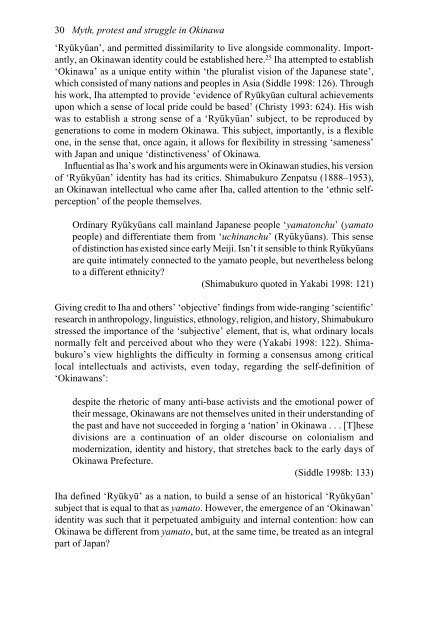Myth, Protest and Struggle in Okinawa
Myth, Protest and Struggle in Okinawa
Myth, Protest and Struggle in Okinawa
Create successful ePaper yourself
Turn your PDF publications into a flip-book with our unique Google optimized e-Paper software.
30 <strong>Myth</strong>, protest <strong>and</strong> struggle <strong>in</strong> Ok<strong>in</strong>awa<br />
‘Ryūkyūan’, <strong>and</strong> permitted dissimilarity to live alongside commonality. Importantly,<br />
an Ok<strong>in</strong>awan identity could be established here. 25 Iha attempted to establish<br />
‘Ok<strong>in</strong>awa’ as a unique entity with<strong>in</strong> ‘the pluralist vision of the Japanese state’,<br />
which consisted of many nations <strong>and</strong> peoples <strong>in</strong> Asia (Siddle 1998: 126). Through<br />
his work, Iha attempted to provide ‘evidence of Ryūkyūan cultural achievements<br />
upon which a sense of local pride could be based’ (Christy 1993: 624). His wish<br />
was to establish a strong sense of a ‘Ryūkyūan’ subject, to be reproduced by<br />
generations to come <strong>in</strong> modern Ok<strong>in</strong>awa. This subject, importantly, is a flexible<br />
one, <strong>in</strong> the sense that, once aga<strong>in</strong>, it allows for flexibility <strong>in</strong> stress<strong>in</strong>g ‘sameness’<br />
with Japan <strong>and</strong> unique ‘dist<strong>in</strong>ctiveness’ of Ok<strong>in</strong>awa.<br />
Influential as Iha’s work <strong>and</strong> his arguments were <strong>in</strong> Ok<strong>in</strong>awan studies, his version<br />
of ‘Ryūkyūan’ identity has had its critics. Shimabukuro Zenpatsu (1888–1953),<br />
an Ok<strong>in</strong>awan <strong>in</strong>tellectual who came after Iha, called attention to the ‘ethnic selfperception’<br />
of the people themselves.<br />
Ord<strong>in</strong>ary Ryūkyūans call ma<strong>in</strong>l<strong>and</strong> Japanese people ‘yamatonchu’ (yamato<br />
people) <strong>and</strong> differentiate them from ‘uch<strong>in</strong>anchu’ (Ryūkyūans). This sense<br />
of dist<strong>in</strong>ction has existed s<strong>in</strong>ce early Meiji. Isn’t it sensible to th<strong>in</strong>k Ryūkyūans<br />
are quite <strong>in</strong>timately connected to the yamato people, but nevertheless belong<br />
to a different ethnicity?<br />
(Shimabukuro quoted <strong>in</strong> Yakabi 1998: 121)<br />
Giv<strong>in</strong>g credit to Iha <strong>and</strong> others’ ‘objective’ f<strong>in</strong>d<strong>in</strong>gs from wide-rang<strong>in</strong>g ‘scientific’<br />
research <strong>in</strong> anthropology, l<strong>in</strong>guistics, ethnology, religion, <strong>and</strong> history, Shimabukuro<br />
stressed the importance of the ‘subjective’ element, that is, what ord<strong>in</strong>ary locals<br />
normally felt <strong>and</strong> perceived about who they were (Yakabi 1998: 122). Shimabukuro’s<br />
view highlights the difficulty <strong>in</strong> form<strong>in</strong>g a consensus among critical<br />
local <strong>in</strong>tellectuals <strong>and</strong> activists, even today, regard<strong>in</strong>g the self-def<strong>in</strong>ition of<br />
‘Ok<strong>in</strong>awans’:<br />
despite the rhetoric of many anti-base activists <strong>and</strong> the emotional power of<br />
their message, Ok<strong>in</strong>awans are not themselves united <strong>in</strong> their underst<strong>and</strong><strong>in</strong>g of<br />
the past <strong>and</strong> have not succeeded <strong>in</strong> forg<strong>in</strong>g a ‘nation’ <strong>in</strong> Ok<strong>in</strong>awa . . . [T]hese<br />
divisions are a cont<strong>in</strong>uation of an older discourse on colonialism <strong>and</strong><br />
modernization, identity <strong>and</strong> history, that stretches back to the early days of<br />
Ok<strong>in</strong>awa Prefecture.<br />
(Siddle 1998b: 133)<br />
Iha def<strong>in</strong>ed ‘Ryūkyū’ as a nation, to build a sense of an historical ‘Ryūkyūan’<br />
subject that is equal to that as yamato. However, the emergence of an ‘Ok<strong>in</strong>awan’<br />
identity was such that it perpetuated ambiguity <strong>and</strong> <strong>in</strong>ternal contention: how can<br />
Ok<strong>in</strong>awa be different from yamato, but, at the same time, be treated as an <strong>in</strong>tegral<br />
part of Japan?
















